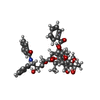+検索条件
-Structure paper
| タイトル | A flipped ion pair at the dynein-microtubule interface is critical for dynein motility and ATPase activation. |
|---|---|
| ジャーナル・号・ページ | J Cell Biol, Vol. 208, Issue 2, Page 211-222, Year 2015 |
| 掲載日 | 2015年1月19日 |
 著者 著者 | Seiichi Uchimura / Takashi Fujii / Hiroko Takazaki / Rie Ayukawa / Yosuke Nishikawa / Itsushi Minoura / You Hachikubo / Genji Kurisu / Kazuo Sutoh / Takahide Kon / Keiichi Namba / Etsuko Muto /  |
| PubMed 要旨 | Dynein is a motor protein that moves on microtubules (MTs) using the energy of adenosine triphosphate (ATP) hydrolysis. To understand its motility mechanism, it is crucial to know how the signal of ...Dynein is a motor protein that moves on microtubules (MTs) using the energy of adenosine triphosphate (ATP) hydrolysis. To understand its motility mechanism, it is crucial to know how the signal of MT binding is transmitted to the ATPase domain to enhance ATP hydrolysis. However, the molecular basis of signal transmission at the dynein-MT interface remains unclear. Scanning mutagenesis of tubulin identified two residues in α-tubulin, R403 and E416, that are critical for ATPase activation and directional movement of dynein. Electron cryomicroscopy and biochemical analyses revealed that these residues form salt bridges with the residues in the dynein MT-binding domain (MTBD) that work in concert to induce registry change in the stalk coiled coil and activate the ATPase. The R403-E3390 salt bridge functions as a switch for this mechanism because of its reversed charge relative to other residues at the interface. This study unveils the structural basis for coupling between MT binding and ATPase activation and implicates the MTBD in the control of directional movement. |
 リンク リンク |  J Cell Biol / J Cell Biol /  PubMed:25583999 / PubMed:25583999 /  PubMed Central PubMed Central |
| 手法 | EM (らせん対称) |
| 解像度 | 8.2 Å |
| 構造データ | |
| 化合物 |  ChemComp-MG:  ChemComp-GTP:  ChemComp-GDP:  ChemComp-TA1: |
| 由来 |
|
 キーワード キーワード | MOTOR PROTEIN/STRUCTURAL PROTEIN / Motor Protein-Cytoskeleton Complex / MOTOR PROTEIN-STRUCTURAL PROTEIN complex |
 ムービー
ムービー コントローラー
コントローラー 構造ビューア
構造ビューア 万見文献について
万見文献について








